Story Eight - Rooms with a View | |
| Story One | Story Two | Story Three | Story Four | Story Five | Story Six | Story Seven | Story Eight | Story Nine | Story Ten | |
| Visit the main River Returns web site >> | |
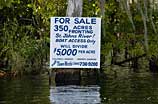 |
Signs, signs, everywhere there are signs. St. Johns riverfront properties are hot commodities. |
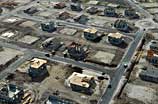 |
The St. Johns River basin area, including St. Johns River County, is expanding rapidly with developments springing up to accommodate the nearly 1000 people per day moving to Florida. |
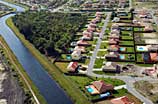 |
Many of Florida's choicest new developments are near bodies of water and most of these developments feature homes with green lawns; some even have covenants that require certain kinds of grass, the lushness of which is dependent on prolific use of fertilizers and pesticides. Collectively, lawns have a huge impact on the river. |
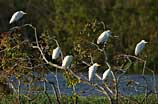 |
Riverfront real estate is much coveted here, on the St. Johns River, not only by birds known as egrets, but also by humans known as developers. |
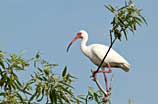 © St. Johns River Water Management District |
The ibis is such a common sight on the St. Johns, it momentarily soothes our concerns about the impact of development on this natural system -- until we stop to consider that magnificent flocks of 50,000 reportedly nested here in the 1940s. |
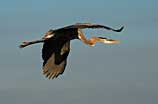 © Jill Heinerth |
An exacting spear fisherman, the great blue heron soars effortlessly up and down the S-curves of the St. Johns, in search of a fish or two for dinner. |
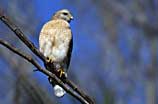 |
The cleanliness of the St. Johns is important to the red-bellied turtles that swim in it and the red-shouldered hawks that glide above it, as well as everything in between. |
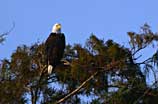 |
Bald eagles feed mainly on fish, which means that the health of the river is vital to this once-endangered species' impressive recovery. |
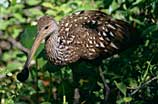 |
The limpkin, an unassuming-looking wading bird related to cranes, is known for its horror-movie-like shriek, a cry that can intimidate even steely nerved river explorers. Limpkins were once common throughout the St. Johns River system. However, impacts on habitat have greatly diminished their numbers to the point where seeing one is a rare privilege. |
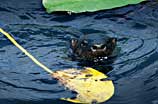 © St. Johns River Water Management District |
River otters, often swimming in pairs or frolicking on the banks in larger groups, are well-camouflaged in the tannic water of the St. Johns, where they forage for fish, crabs, and crayfish. |
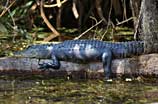 |
The entire length of the St. Johns is known for its prolific population of Mesozoic era relics known as Alligator mississippienis, nowhere more than in Lake Jesup where gators purportedly number around 10,000. Fearsome though these reptiles appear, gator attacks on humans are rare. |
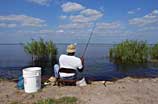 |
A fishin' pole and a clean river make for an idyllic afternoon -- and a tasty evening meal. This modern-day picture of sustenance gathering from the St. Johns River is a connection to the earliest Paleo-Indians who relied upon the river's bounty. |
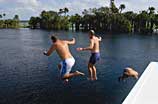 |
Members of the film crew enjoy a swim in the river south of Lake Jesup. A healthy river system is full of clean water that swimmers don't mind getting up their noses and in their ears when they perform crowd-pleasing flips and cannonballs. |
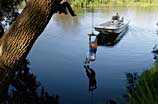 |
The St. Johns River, for all its complexities in hydrology and engineering, is still the source of simple pleasures that hearken back to a slower time. |
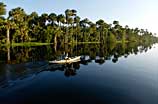 |
The St. Johns River, especially in its slow, curvy, overgrown sections, is heaven for kayakers hoping to sneak up on wildlife. |
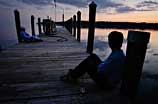 |
The St. Johns is a great place to be watching sunsets, to be boating, to be swimming and to be fishing and . . . well, above all, the river is a great place to simply be. |
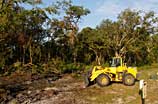 |
Everything looks wild and natural from our perspective on the houseboats, but just beyond the trees on the shoreline we notice a glint of yellow through the foliage: a bulldozer. |
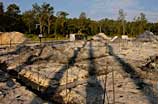 |
Yet another piece of Florida is being developed to accommodate the constant influx of residents and tourists, this one within spittin' distance of the St. Johns, and very close to one of its main tributaries, the Wekiva river. |
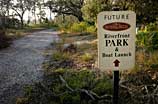 |
A manager for this new construction project along the banks of the St. Johns reasoned that the development will be a net improvement to the river because the new park area and boat ramp required the clean-up of an area where people partied and dumped trash. |
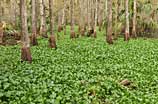 |
Mrs. W.F. Fuller had every intention of beautifying the river when, in 1884, she cast some lovely water hyacinth shoots into the St. Johns. All sorts of misguided, if well-intentioned, actions (such as early canal building in order to drain wetlands) were considered "improvements," the solutions for which have cost taxpayers millions of dollars and decades, if not centuries, of regret. The fact that the water hyacinth debacle still rages makes a person wonder: Will folks 100 years from now look back and wish that we'd known better? |
Water's Journey
The River Returns
Stories of the Great St. Johns
The River Returns web documentary, Copyright © Fusionspark Media, Inc. All Rights Reserved.
All Photos © 2005 Russell Sparkman/Fusionspark Media, Inc., unless otherwise noted.
All Photos © 2005 Russell Sparkman/Fusionspark Media, Inc., unless otherwise noted.
